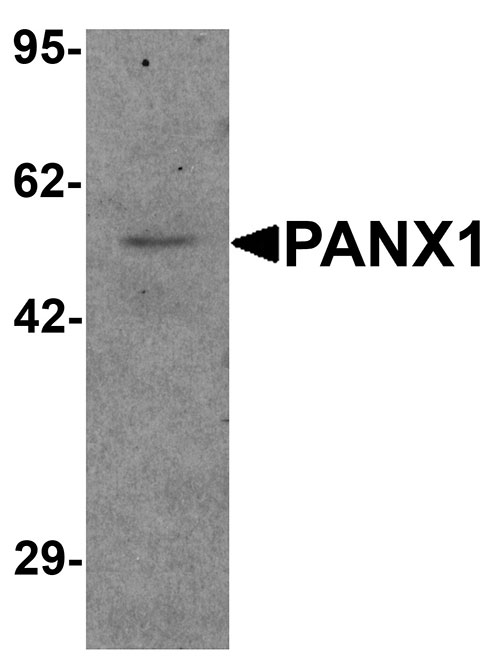PANX1 Antibody
- SPECIFICATION
- CITATIONS
- PROTOCOLS
- BACKGROUND

Application
| WB, IF, E |
|---|---|
| Primary Accession | Q96RD7 |
| Other Accession | NP_056183, 39995064 |
| Reactivity | Human, Mouse, Rat |
| Host | Rabbit |
| Clonality | Polyclonal |
| Isotype | IgG |
| Calculated MW | 47 kDa |
| Application Notes | PANX1 antibody can be used for detection of PANX1 by Western blot at 1 - 2 µg/mL. For immunofluorescence start at 20 µg/mL. |
| Gene ID | 24145 |
|---|---|
| Target/Specificity | PANX1; Two transcript variants encoding different isoforms have been found for this gene. |
| Reconstitution & Storage | PANX1 antibody can be stored at 4℃ for three months and -20℃, stable for up to one year. As with all antibodies care should be taken to avoid repeated freeze thaw cycles. Antibodies should not be exposed to prolonged high temperatures. |
| Precautions | PANX1 Antibody is for research use only and not for use in diagnostic or therapeutic procedures. |
| Name | PANX1 (HGNC:8599) |
|---|---|
| Function | Ion channel involved in a variety of physiological functions such as blood pressure regulation, apoptotic cell clearance and oogenesis (PubMed:15304325, PubMed:16908669, PubMed:20829356, PubMed:20944749, PubMed:30918116). Forms anion-selective channels with relatively low conductance and an order of permeabilities: nitrate>iodide>chlroride>>aspartate=glutamate=gluconate (By similarity). Can release ATP upon activation through phosphorylation or cleavage at C-terminus (PubMed:32238926). May play a role as a Ca(2+)- leak channel to regulate ER Ca(2+) homeostasis (PubMed:16908669). |
| Cellular Location | Cell membrane; Multi-pass membrane protein {ECO:0000255|PROSITE-ProRule:PRU00351}. Endoplasmic reticulum membrane; Multi-pass membrane protein {ECO:0000255|PROSITE-ProRule:PRU00351} |
| Tissue Location | Widely expressed (PubMed:30918116). Highest expression is observed in oocytes and brain (PubMed:30918116). Detected at very low levels in sperm cells (PubMed:30918116) |

Thousands of laboratories across the world have published research that depended on the performance of antibodies from Abcepta to advance their research. Check out links to articles that cite our products in major peer-reviewed journals, organized by research category.
info@abcepta.com, and receive a free "I Love Antibodies" mug.
Provided below are standard protocols that you may find useful for product applications.
Background
PANX1 Antibody: The pannexin gene family encodes a second class of putative gap junction proteins and are highly conserved in invertebrates and mammals. Pannexins (Panx) are four-pass transmembrane proteins that oligomerize to form large pore ion and metabolite-permeable channels. Pannexin-1 (PANX1) and Pannexin-3 are closely related, while Pannexin-2 is a more distant relation. PANX1 is a transmembrane protein that forms a mechanosensitive ATP-permeable channel between adjacent cells and in the endoplasmic reticulum. PANX1 may play a role as a Ca2+ -leak channel to regulate ER Ca2+ homeostasis and regulates neural stem and progenitor cell proliferation.
References
Barbe MT, Monyer H and Bruzzone R. Cell-cell communication beyond connexins: the pannexin channels. Physiology 2006; 21:103-14.
Baranova A, Ivanov D, Petrash N, et al. The mammalian pannexin family is homologous to the invertebrate innexin gap junction proteins. Genomics 2004; 83:706-16.
Sohl G, Maxeiner S and Willecke K. Expression and functions of neuronal gap junctions. Nat. Rev. Neurosci. 2005; 6:191-200
Bao L, Locovei S and Dahl G. Pannexin membrane channels are mechanosensitive conduits for ATP. FEBS Lett. 2004; 572:65-8.
If you have used an Abcepta product and would like to share how it has performed, please click on the "Submit Review" button and provide the requested information. Our staff will examine and post your review and contact you if needed.
If you have any additional inquiries please email technical services at tech@abcepta.com.













 Foundational characteristics of cancer include proliferation, angiogenesis, migration, evasion of apoptosis, and cellular immortality. Find key markers for these cellular processes and antibodies to detect them.
Foundational characteristics of cancer include proliferation, angiogenesis, migration, evasion of apoptosis, and cellular immortality. Find key markers for these cellular processes and antibodies to detect them. The SUMOplot™ Analysis Program predicts and scores sumoylation sites in your protein. SUMOylation is a post-translational modification involved in various cellular processes, such as nuclear-cytosolic transport, transcriptional regulation, apoptosis, protein stability, response to stress, and progression through the cell cycle.
The SUMOplot™ Analysis Program predicts and scores sumoylation sites in your protein. SUMOylation is a post-translational modification involved in various cellular processes, such as nuclear-cytosolic transport, transcriptional regulation, apoptosis, protein stability, response to stress, and progression through the cell cycle. The Autophagy Receptor Motif Plotter predicts and scores autophagy receptor binding sites in your protein. Identifying proteins connected to this pathway is critical to understanding the role of autophagy in physiological as well as pathological processes such as development, differentiation, neurodegenerative diseases, stress, infection, and cancer.
The Autophagy Receptor Motif Plotter predicts and scores autophagy receptor binding sites in your protein. Identifying proteins connected to this pathway is critical to understanding the role of autophagy in physiological as well as pathological processes such as development, differentiation, neurodegenerative diseases, stress, infection, and cancer.



